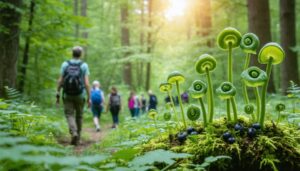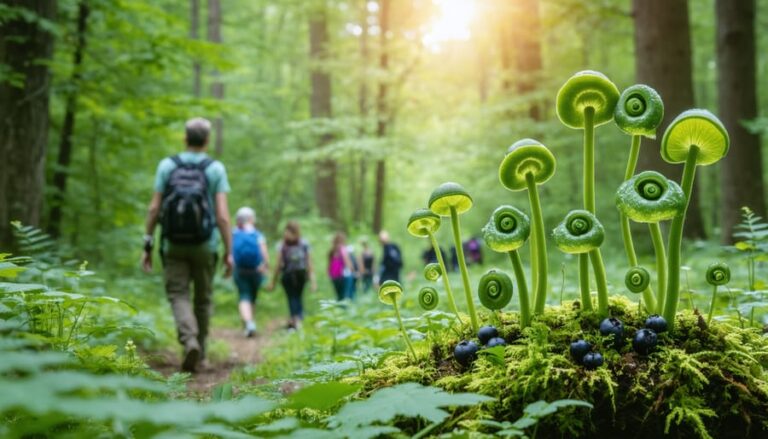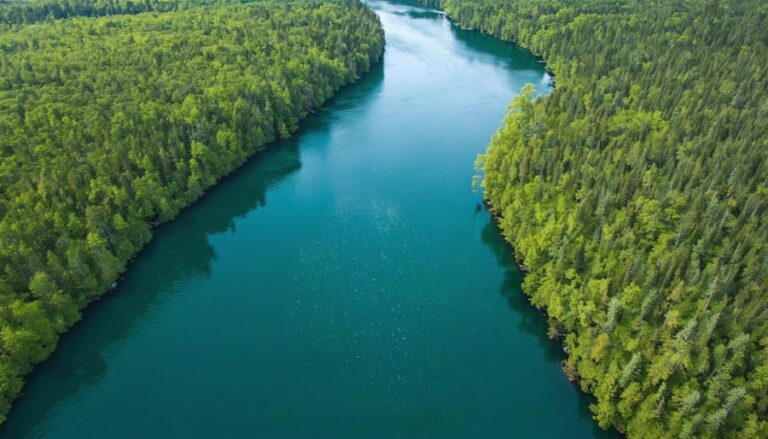Ontario’s breathtaking landscape presents a unique tapestry where land meets water, creating vibrant ecosystems that support an incredible diversity of life. From the dense boreal forests that sweep down to meet the Great Lakes to the countless rivers and wetlands that dot our province, these terrestrial and aquatic environments work in perfect harmony to sustain thousands of species.
Along our shorelines, you’ll witness nature’s remarkable transition zones where deer pause to drink alongside great blue herons, while painted turtles bask on fallen logs and kingfishers dive for minnows. These edge habitats showcase the vital connection between land and water, demonstrating how species adapt to thrive in both realms.
Understanding this delicate balance between terrestrial and aquatic ecosystems isn’t just fascinating – it’s essential for preserving Ontario’s natural heritage. Whether you’re an avid naturalist, weekend explorer, or curious newcomer, discovering how these interconnected worlds support each other reveals the incredible story of life in our province’s diverse landscapes.
The Meeting Point: Ontario’s Shoreline Ecosystems

Wetlands and Marshes
Ontario’s wetlands and marshes are nature’s ultimate transition zones, where Ontario’s freshwater wetlands create a fascinating bridge between land and water ecosystems. These magical spaces act like natural sponges, filtering water and providing essential habitat for countless species. Keep your eyes peeled for great blue herons stalking through the cattails, or listen for the distinctive plop of a painted turtle sliding off a log.
During spring and fall migrations, these wetlands transform into bustling rest stops for thousands of waterfowl. I’ve spent countless dawns watching wood ducks and Canada geese touch down among the lily pads, creating ripples that spread across the mirror-like surface. Pro tip: visit the marshes during early morning or dusk for the best wildlife viewing opportunities, and don’t forget to bring your binoculars and a good waterproof jacket – the rewards of patient observation are absolutely worth it!
Riparian Zones
Picture a living bridge between land and water – that’s exactly what riparian zones are! These vibrant riverside areas serve as nature’s own transition zones, where terrestrial and aquatic worlds blend seamlessly together. In Ontario, you’ll find these special habitats along the edges of our countless lakes, rivers, and streams, creating crucial corridors for wildlife.
These zones are absolute powerhouses of biodiversity, where towering silver maples and willows sink their roots into rich, moist soil. Their branches provide perfect perches for kingfishers scanning the waters below, while fallen logs create hiding spots for both land-dwelling creatures and aquatic life.
Here’s a cool fact: riparian zones actually help keep our waters clean! The vegetation acts like a natural filter, catching sediment and pollutants before they reach the water. They’re also nature’s flood control system, absorbing excess water during heavy rains and preventing erosion. Keep an eye out for these amazing transition zones on your next waterside walk – they’re truly where the magic happens!
Terrestrial Animals That Depend on Water
Amphibians of Ontario
Ontario’s diverse wetlands and forests are home to a fascinating variety of Ontario’s native wildlife species, including 13 species of frogs and toads, and 11 species of salamanders. You’ll commonly spot American Bullfrogs making their distinctive deep “jug-o-rum” calls near ponds, while Spring Peepers announce the arrival of warmer weather with their high-pitched chorus.
The Eastern Red-backed Salamander is a frequent sight during nature walks, hiding under fallen logs in moist woodlands. One of our most spectacular amphibians is the Blue-spotted Salamander, which you might glimpse during its early spring migration to breeding ponds.
Keep an eye out for the iconic Green Frog, often mistaken for its larger cousin, the Bullfrog. These adaptable creatures can be found in both permanent and temporary water bodies throughout the province. For the best amphibian viewing, visit wetland areas during spring evenings when many species are most active. Remember to watch your step and never handle these sensitive creatures – their permeable skin makes them vulnerable to chemicals on our hands.
Water-Dependent Mammals
Ontario’s waterways are home to some fascinating mammals that have perfectly adapted to life both in and around water. Beavers, nature’s master engineers, are perhaps the most iconic of these species. These industrious creatures shape our landscapes by building dams and lodges, creating vital wetland habitats that benefit countless other species.
River otters are another charismatic resident of our waterways, often spotted playing and sliding down muddy banks. Their playful nature and graceful swimming make them a favorite among wildlife watchers, especially in early morning or late evening hours when they’re most active.
Muskrats, though less celebrated than their larger cousins, are equally fascinating. These skilled swimmers build their homes in riverbanks and can stay underwater for up to 15 minutes. Keep an eye out for their V-shaped swimming patterns rippling across still waters.
Pro tip: Dawn and dusk are the best times to spot these water-loving mammals. Bring binoculars and maintain a quiet presence near shorelines – patience will reward you with unforgettable wildlife encounters. Remember to keep your distance and never disturb their habitats or feeding areas.


Aquatic Life Beyond the Surface
Native Fish Species
Ontario’s waters teem with fascinating native fish species that have called these lakes and rivers home for thousands of years. The mighty Lake Trout, Ontario’s official provincial fish, dominates the deep, cold waters of our larger lakes, while the striking Brook Trout, with its distinctive speckled pattern, thrives in countless crystal-clear streams.
In the warmer waters, you’ll find the popular Smallmouth and Largemouth Bass, beloved by anglers for their spirited fights. The Yellow Perch and Walleye are not only important for recreational fishing but also play crucial roles in the local food web. The Northern Pike, known for its aggressive hunting style, can often be spotted lurking in weed beds near shorelines.
Perhaps most iconic is the Lake Sturgeon, a living fossil that has remained virtually unchanged for millions of years. These gentle giants can grow to impressive sizes and serve as a reminder of our waters’ rich biodiversity. Keep an eye out for the distinctive Muskellunge too – these elusive predators are considered the ultimate trophy fish in Ontario’s waters.
Remember to obtain proper fishing licenses and follow local regulations to help preserve these magnificent species for future generations.
Underwater Plants and Invertebrates
Ontario’s underwater ecosystems teem with fascinating wetland plant life and tiny creatures that form the foundation of aquatic food chains. Water lilies dance on the surface while underwater grasses like pondweed and coontail create essential hiding spots for small fish and invertebrates. These plants not only produce oxygen but also help maintain water quality by absorbing excess nutrients.
Below the surface, you’ll discover an intricate world of freshwater invertebrates. Crayfish scuttle along the bottom, while dragonfly nymphs dart between plants hunting for smaller prey. Water snails methodically clean algae from rocks and plants, acting as nature’s maintenance crew. During summer evenings, you might spot the ethereal glow of freshwater jellyfish, a unique sight in Ontario’s lakes.
Pro tip: The best way to observe these underwater communities is to visit shallow bays during early morning hours when the water is calmest. Bring a clear-bottom bucket or aquascope to peek into this fascinating underwater world without disturbing its delicate balance.
Best Spots for Wildlife Viewing
Ontario offers several prime locations where you can witness the fascinating interaction between land and water wildlife. Algonquin Provincial Park stands out as a crown jewel, where lucky visitors might spot moose wading in shallow waters during early morning hours, while beavers busily construct their lodges nearby.
Along the Bruce Peninsula, the Singing Sands area provides an excellent vantage point for observing both shorebirds and underwater life. The crystal-clear waters make it perfect for spotting fish species, while the surrounding wetlands attract diverse bird species and amphibians.
Point Pelee National Park, particularly during spring and fall migrations, offers unparalleled opportunities to see waterfowl, songbirds, and monarch butterflies. The park’s unique position and varied ecosystems make it a natural funnel for wildlife movement between land and water habitats.
Insider tip: Visit the Long Point Provincial Park early in the morning or just before sunset for the best wildlife viewing opportunities. The marshlands here are especially active during these golden hours, with turtles basking on logs and great blue herons fishing in the shallows.
For a less-traveled option, consider the Minesing Wetlands near Barrie. This hidden gem supports an incredible diversity of species, from river otters and mink to various fish species and wetland birds. Remember to bring binoculars and maintain a respectful distance from wildlife.
Pro tip: Always check seasonal wildlife viewing schedules before visiting, as many species are more active during specific times of the year. Pack a good camera with a zoom lens, and remember to follow the park’s guidelines for responsible wildlife viewing.
As we’ve explored Ontario’s rich tapestry of terrestrial and aquatic ecosystems, it becomes clear that these environments are not separate entities but deeply interconnected systems that rely on each other for survival. Each of us plays a crucial role in preserving these delicate habitats for future generations. Whether you’re hiking along a woodland trail or paddling through serene waters, remember to practice the leave-no-trace principle and maintain a respectful distance from wildlife.
Consider joining local conservation groups or participating in citizen science projects to contribute to ecosystem protection. Even simple actions, like properly disposing of fishing lines or keeping your dogs leashed in sensitive areas, can make a significant difference. By sharing your wildlife encounters responsibly on social media and educating others about the importance of these habitats, you help build a community of conscious nature enthusiasts.
Together, we can ensure that Ontario’s diverse terrestrial and aquatic ecosystems continue to thrive, providing endless opportunities for discovery and wonder for generations to come.














+ There are no comments
Add yours